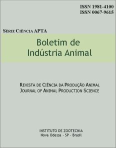Behavior of four different mixed pastures of Central Cerrado of State of São Paulo. II. Animal production
Abstract
The experiment was conducted from January, 1979 to January, 1984 at the Posto de Avicultura de Brotas State of São Paulo, Brazil, with the objective of selecting, among four different mixed pastures, the one(s) more promising to the Cerrado Region of the State of São Paulo. It was used the continuous grazing system with variable stocking rate along the year and each pasture was represented by three paddocks of different sizes, which were maintained at a given time with the same number of animals. It was studied the relations animal x kind of pasture, acumulated liveweight gains per head and the animal production potential, by using the grazing production curves. For the pattern mixture (molasses-grass + stylo) the estimated stocking rate to obtain the maximum liveweight gain per area was 0.42 AU/ha, giving an liveweight daily gain of 489 g/AU and 210 g/ha, being of 3.999 kg/AU and 1.680 kg/ha the amount of forage, as total dry rnatter of the mixture, maintained under grazing. In the comparison of the animal production potencial of the studied mixtures versus the pattern mixture it was observed, by the results of the co-variance analysis, that the animal production potencial per head of the green panic + centro mixture was higher than the one of the pattern mixture (P < 0.01), while considering the production potential per area, the cries of the mixtures transvala + pigeon pea (P < 0.01) and green panic + centro (P < 0.05) wore the highest. The mixture setaria + siretro did not differ from the pattern mixture either in the production per head or the production per area, but like the transvala + pigeon pea mixture, permitted a greater stocking rate.Downloads
Downloads
Published
Issue
Section
License
Os autores não serão remunerados pela publicação de trabalhos, pois devem abrir mão de seus direitos autorais em favor deste periódico. Por outro lado, os autores ficam autorizados a publicar seus artigos, simultaneamente, em repositórios da instituição de sua origem, desde que citada a fonte da publicação original seja Boletim de Indústria Animal. A revista se reserva o direito de efetuar, nos originais, alterações de ordem normativa, ortográfica e gramatical, com vistas a manter o padrão culto da língua e a credibilidade do veículo. Respeitará, no entanto, o estilo de escrever dos autores. Alterações, correções ou sugestões de ordem conceitual serão encaminhadas aos autores, quando necessário. Nesses casos, os artigos, depois de adequados, deverão ser submetidos a nova apreciação. As opiniões emitidas pelos autores dos artigos são de sua exclusiva responsabilidade. Todo o conteúdo deste periódico, exceto onde está identificado, está licenciado sob a Licença Creative Commons Attribution (CC-BY-NC). A condição BY implica que os licenciados podem copiar, distribuir, exibir e executar a obra e fazer trabalhos derivados com base em que só se dão o autor ou licenciante os créditos na forma especificada por estes. A cláusula NC significa que os licenciados podem copiar, distribuir, exibir e executar a obra e fazer trabalhos derivados com base apenas para fins não comerciais.













